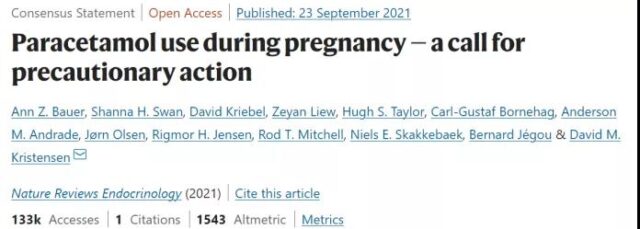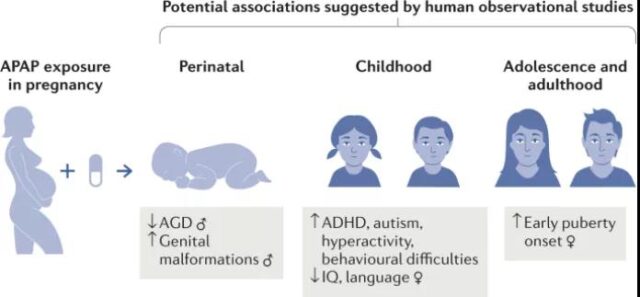Excessive use of antipyretics during pregnancy may increase birth defects
- Engineered Soybeans with Pig Protein: A Promising Alternative or Pandora’s Dish?
- Severe Fever with Thrombocytopenia Syndrome (SFTS): A Tick-Borne Threat with High Mortality
- Why Isolating Bananas Extends Their Shelf Life?
- This common vitamin benefits the brain and prevents cognitive decline
- New report reveals Nestlé adding sugar to infant formula sold in poor countries
- Did Cloud Seeding Unleash a Deluge in Dubai?
Excessive use of antipyretics during pregnancy may increase birth defects
- Red Yeast Rice Scare Grips Japan: Over 114 Hospitalized and 5 Deaths
- Long COVID Brain Fog: Blood-Brain Barrier Damage and Persistent Inflammation
- FDA has mandated a top-level black box warning for all marketed CAR-T therapies
- Can people with high blood pressure eat peanuts?
- What is the difference between dopamine and dobutamine?
- How long can the patient live after heart stent surgery?
Excessive use of antipyretics during pregnancy may increase birth defects
Paracetamol (Paracetamol, also known as paracetamol or APAP) is one of the most commonly used antipyretic analgesics in the world. Approximately half of pregnant women worldwide have used APAP. However, in recent years, many studies have claimed that such drugs may have adverse effects on fetal development.
In late September, “Nature Review: Endocrinology” published a “consensus statement” jointly written by 13 scientists from the United States, Britain, Israel, Europe, Canada, Brazil and Australia. The article shows that a retrospective analysis of the past 25 years of research has found that excessive use of APAP during pregnancy may cause developmental problems such as the fetal nervous system and genitourinary system.
This potential hazard has a dose-dependent relationship, and it is more prominent in two cases: first, continuous medication for more than two weeks has the greatest impact. Second, take medication in the first trimester.
This “consensus statement” has been signed and supported by 91 clinicians and researchers worldwide.

26 cohort studies showed that medications during pregnancy: Child suffers
“In more than 600 prescription drugs and over-the-counter drugs, APAP is the active ingredient.” The first author of the “Consensus Statement”, Ann Z. Bauer, a postdoctoral fellow in epidemiology at the University of Massachusetts Lowell, wrote in an article that studies have found that APAP is An endocrine disruptor that can cross the placental barrier and affect the development of the nervous system during the fetal period. Some studies also believe that long-term use of APAP, or reducing the antioxidant content in serum, destroys the physiological balance of oxidants and antioxidants in the body. The increase of oxidant content in the fetus will induce oxidative stress and neurotoxicity, which will lead to the death of neurons.
However, many studies support that APAP is used during pregnancy to reduce fever and pain. If high fever and severe pain are not treated in time, they will affect the development of the fetus or the health of the mother at the same time.
In order to clarify the opinions of all parties, the “Consensus Statement” uses the timeline from January 1, 1995 to October 25, 2020, to comprehensively search PubMed’s published animal experiment and epidemiological literature, and only include APAP as an independent risk factor Investigation and research carried out.
The “Consensus Statement” reviewed and analyzed 29 epidemiological studies and animal experiments related to the use of APAP during the perinatal period, and fetal neurology, urinary and reproduction. Among them, 26 cohort studies suggested that there was a correlation with birth defects.
For example, a large cohort study of 64,322 children showed that mothers taking APAP during pregnancy significantly increased the risk of attention deficit/hyperactivity disorder (ADHD) in children. Especially in the middle and late pregnancy, and when the frequency of medication during pregnancy is high, the risk of ADHD in the offspring is higher. After adjusting for confounding factors such as the mother’s own inflammatory diseases and pregnancy infections, this risk correlation still exists significantly.
In addition, the “Consensus Statement” cited data from the “U.S. National Health Interview Survey”. From 2009 to 2017, about 1/6 of children aged 3-17 were diagnosed with developmental disabilities. Comparing the data from 2009-2011 and 2015-2017, the overall incidence of developmental disabilities increased by 9.5%. At the same time, in the western United States, the prevalence of male genitourinary diseases has increased, including cryptorchidism, hypospadias, and testicular germ cell cancer, as well as precocious puberty, decreased sperm count, decreased sex hormone levels, and decreased fertility. In addition, 4 independent studies have found that APAP exposure before childbirth can reduce women’s reproductive health and fertility in adulthood.
Parallel to the above data, the use of APAP during pregnancy is on the rise. Ann Z. Bauer said: “We are witnessing a disturbing increase in the number of children with cognitive, learning, and/or behavioral problems. The effect of the drug may be small, but given that it is widely used, even if it is small The effect size may also translate into an increase in the incidence of the entire population.”
“What’s worrying is that most cohort studies have shown that there are cognitive misunderstandings in maternal medication.” Ann Z. Bauer explained. First, most people know that unnecessary medications should be avoided during pregnancy. But 80% will take at least one prescription or over-the-counter drug during pregnancy. APAP is the most common drug exposure, and even its use is likely to be underestimated. Studies have shown that many people will not report a history of APAP medication unless specifically asked. Second, about 1/3 of pregnant women use APAP to reduce fever. However, some pregnant women, without the guidance of obstetrics or pharmacy, use APAP to treat chronic pain, low back pain and migraine when the cause of the disease is unknown.
The “Consensus Statement” recommends that medication education before pregnancy or early pregnancy should be strengthened, including:
- Use APAP only when there are clear medical indications;
- If pregnant women are unsure whether they need to use APAP, they should consult a specialist doctor or pharmacist;
- Use the lowest effective dose in the shortest possible time to minimize the risk.

Too large doses and long treatment courses are unfavorable
“Nature Review: Endocrinology” published an editorial at the same time, stating that the “consensus statement” does not call for the prohibition of APAP, but suggests that it should be used with caution during pregnancy or under the guidance of obstetricians and pharmacists. This is almost consistent with the recommendations provided by current obstetric clinical practice and the clinical usage habits of most obstetricians and gynecologists.
The editorial stated that APAP is widely regarded as the safest option for pain relief and fever reduction during pregnancy, and it is also the first choice. Other anti-fever drugs, such as non-steroidal anti-inflammatory drugs, are forbidden to use at or after 20 weeks of pregnancy to prevent the risk of insufficient amniotic fluid.
Currently, APAP is classified as Class B in the US Food and Drug Administration (FDA) “Pregnancy Drug Safety Classification System” and can be used throughout pregnancy. The European Medicines Agency (EMA) recommends that APAP can be used during pregnancy at the lowest effective dose and for the shortest possible time. Both the FDA and EMA are studying the effects of APAP during pregnancy on the disease of the offspring, and there is no conclusion yet.
Ian Musgrave, a pharmacologist at the University of Adelaide in Australia, agreed with the above call, but he emphasized that the use of any drug is a balance between benefits and potential harm. “Fever is a recognized risk factor that can cause greater harm to the fetus. What we need to do is to find a balance between the pain and fever, treated or untreated, and the risk of potential harm to the pregnant woman and/or the fetus. .”
“APAP’s pregnancy classification is B, so in our hospital, it is allowed to be used for a short period of time for pregnant women with a cold and fever.” Zhai Xiaobo, director of the Pharmacy Department of Shanghai Tongji University Oriental Hospital, told the “medical community” that he has not seen it so far. To reports of birth defects caused by the use of APAP.
However, Zhai Xiaobo personally believes that the aforementioned scientists’ idea of ”short-term low-dose oral APAP during pregnancy” is correct. “Cold and fever are self-limiting diseases. If the pregnant woman’s body temperature is not very high and the degree of soreness is not severe, no medicine is needed. If fever or soreness occurs, give oral medicine, and the dose is too large and the course of treatment is too long. It will have an adverse effect.”
The “consensus statement” stated that there are limitations in the existing epidemiological literature regarding the use of APAP and a lack of rigorous meta-analysis. Considering that the drug is also the most commonly used anti-fever drug for infants, more research is needed to determine its safety.
sources:
1. Tylenol could be risky for pregnant women – a new review of 25 years of research finds acetaminophen may contribute to ADHD and other developmental disorders in children. The Conversation
2.Paracetamol use during pregnancy — a call for precautionary action. Nature Reviews Endocrinology (2021). doi.org/10.1038/s41574-021-00553-7
3.Association of Acetaminophen Use During Pregnancy With Behavioral Problems in Childhood: Evidence Against Confounding. JAMA Pediatr. 2016 Oct 1;170(10):964-970. doi:10.1001/jamapediatrics.2016.1775
4.Acetaminophen use during pregnancy, behavioral problems, and hyperkinetic disorders. JAMA Pediatr. 2014 Apr;168(4):313-20. doi: 10.1001/jamapediatrics.2013.4914
Excessive use of antipyretics during pregnancy may increase birth defects
(source:internet, reference only)
Disclaimer of medicaltrend.org
Important Note: The information provided is for informational purposes only and should not be considered as medical advice.



